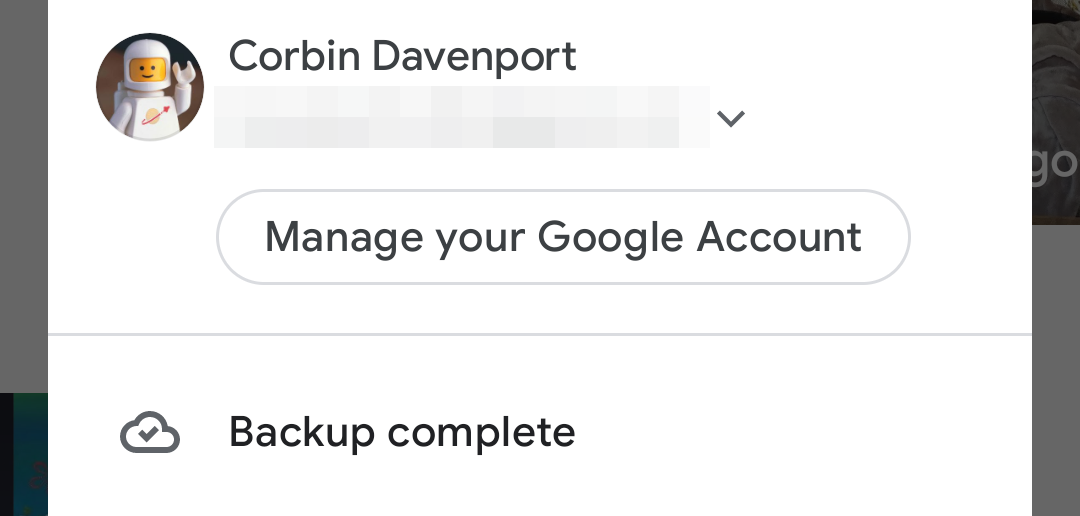how can i get my phone back to what is was before factory reset
Read update
- This guide has been updated to reflect contempo changes to Google Photos and Samsung One UI.
For most of usa, the bulk of our important data (letters, calendars, contacts, and and so on) lives in the cloud. However, your telephone or tablet might all the same have some information not being backed up to the cloud, depending on the apps you use and the sync/backup services you accept enabled. For this guide, we'll exist going over some of the ways you can support this data and ensure it makes information technology to your next phone or tablet.
Bank check account sync status
Checking Android's sync status for your cloud accounts is a good first pace. This makes sure everything that should be backed upwardly is really beingness backed upward. Open the Settings app, tap the Accounts selection, select your principal Google business relationship, and verify that all the apps and services under the account have been synced recently. The settings might look slightly different (or be in dissimilar places) depending on your device.
If some of the services haven't been synced recently, tap the Sync Now push button on the page. Depending on your version of Android, the Sync Now pick might be under a menu. The reason to check this area is simple: sometimes synchronization breaks.
Make sure your photos and videos are backed up
If y'all apply Google Photos to support the photos and videos you take with your telephone or tablet, y'all should make sure it's still doing that. All y'all take to do is open the Photos app, tap your profile icon in the top-right corner, and bank check for the 'Backup complete' message. If Photos isn't backing up your media, it will testify a 'Backup is off' message instead.

Google is ending unlimited backups in Google Photos, so if y'all have a lot of media, it might exist a proficient thought to delete unneeded images and videos before enabling backups in Google Photos. For example, Samsung phones and tablets place all screenshots in the Camera directory that Photos monitors for backups, which can quickly consume up your account's available storage.
Of course, there are enough of other photo backup apps for Android, including OneDrive and Dropbox. If you lot're using one of those, go into the app'south settings and check the current sync status. You can too import photos manually into these apps if yous just want sure files or folders.
Bankroll up media to a flash drive
If yous have enough storage on your flash drive, and an adapter if i is needed (either Type-C or microUSB), you lot can just re-create your phone's unabridged camera folder to the drive. Plug the bulldoze into your phone, then use the Files app (or the file manager of your pick) on your device to copy the 'DCIM' folder on your telephone to the drive. Any other folders and types of files, like your Downloads folder, tin can exist copied just equally easily.
Every phone manufacturer has a unlike file manager, so if you can't figure it out, download Files by Google from the Play Shop. In one case yous've opened the app, here'southward what y'all need to do:
- Go the 'Browse' tab.
- Select your internal storage
- Discover the 'DCIM' binder in the listing and hold downwards on information technology until a checkmark appears.
- Tap the menu button at the height-right and select 'Copy to'.
- Select your flash bulldoze in the list.
Once your files are copied, you can disconnect the flash bulldoze and support the photos however you see fit.
Backing upwards files to a PC
If you have a computer with plenty storage, you can also simply connect your phone or tablet over USB and copy the DCIM (and/or other desired folders) in a few clicks. Make sure your phone is in MTP (file transfer) mode from the notification shade, and non ready to charge or some other USB connexion fashion.
Bankroll up files to a Mac
The official method for copying files to and from a Mac is the Android file transfer tool. This app is so notoriously bad and out of date that basically no 1 recommends using it. Information technology often just straight up refuses to work, and is a large headache all around. Nosotros have a dedicated article here with some other software you can try.
When yous create a contact or calendar event, your phone might give you the option of saving the information in the phone's internal storage, instead of in the cloud. While that's a nice feature to take, especially for the privacy-witting, information technology likewise means you might take saved some important information locally if you didn't pay close attention. Earlier yous wipe our telephone, you should check to come across if any of your contacts or agenda events aren't backed upward to the cloud. It's likewise possible to shop a limited number of contacts on your telephone's SIM menu, only this isn't a common do anymore, and then it'southward pretty hard to practise it accidentally.
Some phones, like Google Pixel devices, don't fifty-fifty give you lot the pick of saving contacts and calendars locally.
The exact procedure for this varies past telephone model, just y'all tin can start by opening the Contacts app and looking for a carte du jour with all your accounts. For example, the Contacts application on recent Samsung phones displays 'Phone' alongside your Samsung and Google accounts. Some devices have an option to move Telephone contacts to an online business relationship, just in some cases, you lot'll take to export the file (normally attainable through the Share button) and import it using Google Contacts on the spider web.
Copying a local contact to Google with a Samsung Milky way telephone
Checking for locally-stored agenda events is mostly the aforementioned process: open up your Calendar app and await for a calendar non linked to any accounts. Information technology's commonly called 'Phone' or 'My calendar'. Notwithstanding, nigh mobile agenda apps don't requite you an easy way to export calendars. The best manner to exercise this is to install this utility from the Play Shop, open up it, select your phone'southward calendar, and tap the 'Consign' push button. This will give you an .ics agenda file, which you can import into Google Calendar, Outlook, or any other cloud service.
Remove online accounts and disable Device Protection
If y'all're selling your phone, or giving information technology to someone else, you'll demand to log out from all your Google accounts and remove any lock screen passwords. Android introduced a feature called 'Device Protection' back in 2015, which requires you to enter the password of the last Google business relationship used on the device, after the device has been wiped in many cases.
While Google does say that Device Protection shouldn't trigger a password bank check subsequently factory reset on near phones, re moving your Google accounts and lockscreen before resetting is the only way to guarantee it won't.
To disable Device Protection, you'll first need to log out of all your Google accounts. Open the Settings app on your telephone, become to the Accounts section, and tap 'Remove account' under each account.
Removing accounts on a Google Pixel telephone
Removing accounts on a Samsung Galaxy phone
Once you've washed that, disable any lock screen passwords you might accept. This can exist done from the Security section of the Settings app.
UPDATE: 2021/02/20 nine:26am PST By CORBIN DAVENPORT
This guide has been updated to reflect contempo changes to Google Photos and Samsung One UI.
Virtually The Author
Source: https://www.androidpolice.com/2021/02/20/how-to-back-up-your-android-phone-before-a-factory-reset/

0 Response to "how can i get my phone back to what is was before factory reset"
Post a Comment